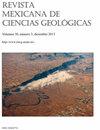在Oxia平原和Mawrth Vallis ExoMars着陆点绘制矿物学图-水蚀变和古环境演化的意义
IF 0.5
4区 地球科学
Q4 GEOSCIENCES, MULTIDISCIPLINARY
Revista Mexicana De Ciencias Geologicas
Pub Date : 2023-07-30
DOI:10.22201/cgeo.20072902e.2023.2.1744
引用次数: 0
摘要
矿物学研究是研究火星地质过程的主要工具之一。在此,基于火星勘测轨道飞行器的CRISM紧凑型火星勘测成像光谱仪、火星全球勘测者的TES热发射光谱仪和火星快车的OMEGA可见光和红外矿物学测绘光谱仪的多光谱数据集,对ExoMars着陆点Oxia Planum和Mawrth Vallis的矿物学进行了分析和解释。对碳酸盐、氧化物、硅酸盐和硫酸盐矿物群的原生和次生矿物进行了表征,其中大多数矿物是由水蚀变产生的,已鉴定出35种矿物,其中层状硅酸盐是主要矿物群。共存的矿物类型指向不同的热液和蚀变阶段。我们的研究支持,早期火星上一定存在浅表和内源性过程中的水,导致次生矿物的直接沉淀和转化,其中一些通常不会同时形成。因此,由于火星气候的变化,物种可能在不同的时间出现。一些矿物可能是在地下形成的。火星的古环境可能包括陆上、水下和浅层地下热液系统、冷泉、碱性湖泊、萨卜哈和普拉亚。我们的研究结果有助于我们了解计划中的着陆点,为ExoMars火星车任务可能遇到的情况做准备,突出了水可能对矿物成因、蚀变过程及其天体生物学潜力产生的影响。本文章由计算机程序翻译,如有差异,请以英文原文为准。
Mapping the mineralogy in the Oxia Planum and Mawrth Vallis ExoMars landing sites – implications for aqueous alteration and paleoenvironmental evolution
Mineralogical studies constitute one of the main tools to investigate geological processes on Mars. Here, the mineralogy of the ExoMars landing sites Oxia Planum and Mawrth Vallis is analyzed based on multispectral datasets of the CRISM Compact Reconnaissance Imaging Spectrometer for Mars of Mars Reconnaissance Orbiter, TES Thermal Emission Spectrometer of Mars Global Surveyor and OMEGA Visible and Infrared Mineralogical Mapping Spectrometer of Mars Express are integrated and interpreted. Primary and secondary minerals of carbonates, oxides, silicates and sulphates mineral groups are characterized, with most minerals produced by aqueous alteration, with 35 mineral species identified, amongst which phyllosilicates are the dominant group. Coexisting mineral types point to distinct hydrothermal and alteration stages. Our investigation supports that water must have been present on early Mars on superficial and endogenous processes, causing direct precipitation and transformations of secondary minerals, with some not usually formed simultaneously. Hence, it is likely that species may have arisen at different times, due to changes of Martian climate. Some minerals may have formed in the subsurface. The Martian palaeoenvironments might include subaerial, underwater, and shallow subsurface hydrothermal systems, cold springs, alkaline lakes, sabkhas, and playas. Our results contribute to our understanding of the planned landing sites to prepare for what the ExoMars rover mission may encounter, highlighting the impact that water may have had on the mineral genesis, alteration processes and their astrobiological potential.
求助全文
通过发布文献求助,成功后即可免费获取论文全文。
去求助
来源期刊

Revista Mexicana De Ciencias Geologicas
地学-地球科学综合
CiteScore
1.00
自引率
12.50%
发文量
0
审稿时长
6-12 weeks
期刊介绍:
Revista Mexicana de Ciencias Geológicas (RMCG) publishes original research papers on geological processes of broad interest, and particularly those dealing with regions of Latin America. The RMCG also publishes review papers on topics of current interest, and on the geology and tectonics of geological provinces of Latin America. Besides, it offers the opportunity for host editors to publish special thematic issues.
 求助内容:
求助内容: 应助结果提醒方式:
应助结果提醒方式:


